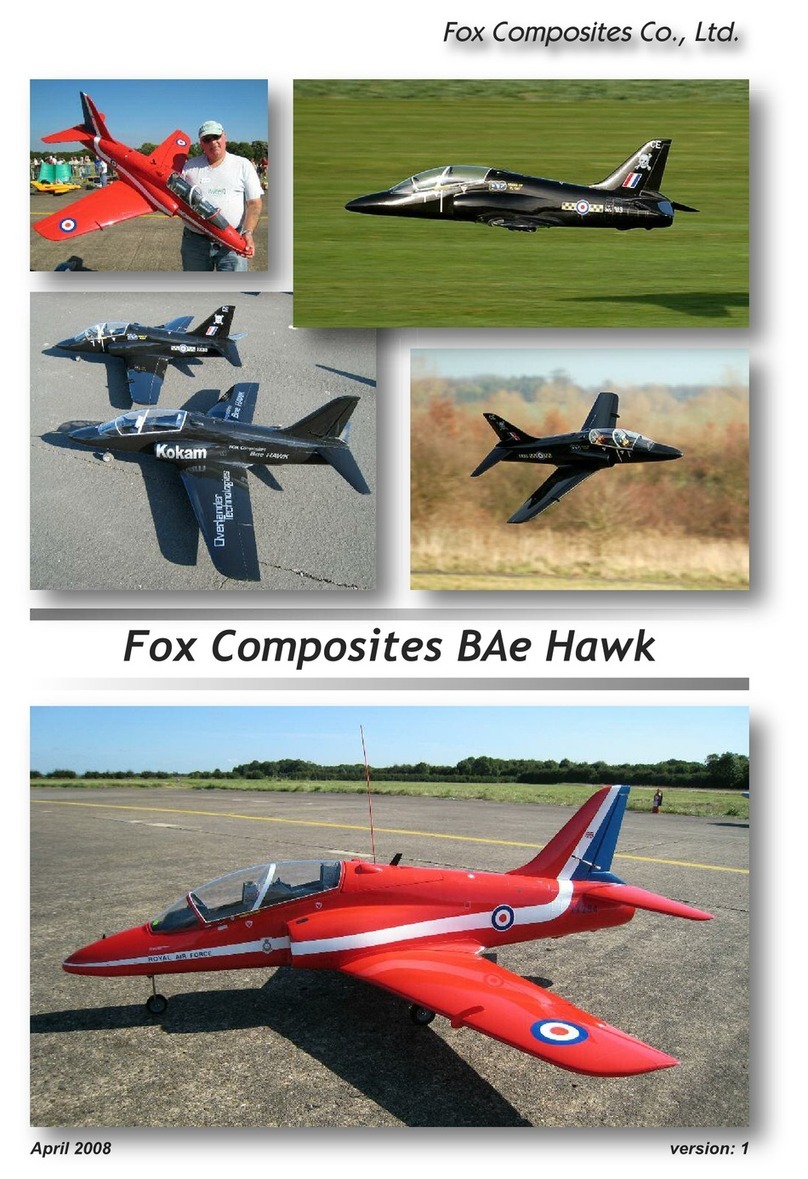Equip ent and Accessories
In addition to the kit contents you will need some accessories, R/C, and small hardware items to
complete your ‘Komet’. Below are our recommendations, from experience with the prototypes.
Motor: The Komet has been designed primarily for electric flight, for a Speed-400 sized
motor of 400 - 700 watts. We used a Mega-motor 16/15/3 (400 watt) in the first prototype, which
gave more than adequate performance and ran very cool. Currently we are using a 700 watt Ty-
phoon 2W-20 from Overlander Technologies, which gives amazing performance and easy hand-
launches, even in zero-wind conditions. With both motors we’ve been using APC thin & raupner
CAM electric propellers, both 4.75 x 4.75” size, and can recommend these. Larger props provide
too much load, and can lead to overheating of system components.
Speed-Controller (ESC): You will need a suitable speed-controller (with BEC circuit) that matches
your chosen electric motor and battery packs. Please follow the recommendations of the motor
supplier for the rating. For the 700 watt motor we have been using a ‘Castle Creations’ Phoenix
60 amp unit, which has been working very well indeed on both 3S1P and 4S1P Lipo packs.
The power package for this plane was developed in conjuction with Overlander Technologies in
the UK (www.overlander.co.uk). It is very important to have a well matched combination of motor,
ESC and batteries for good performance, without overheating any of the system components.
Flight batteries: Any good quality 3S1P or 4S1P Lipo pack of at least 2200mAH will be fine. Ex-
pect about 3.5 - 4.5 minute flights with a battery of this capacity. We are currently using Kokam
2200 (3S) and 3200 (4S) packs.
Ser os: You will need 2 ‘thin’ digital wing servos for the elevons, of minimum 3.5kg torque,
such as the JR DS161 or Hitec HS-5125 M , and the servo mounts are milled to suit these. If you
fit the optional rudder, then any mini servo of min. 2.5kg torque should be sufficient.
About the Me-163 ‘Ko et’
The Fox Composites ‘Komet’ was designed as a semi-scale electric ‘fun-fly’ model. Normally the
model is hand-launched, but you could also use a very short bungee system if you fly on your
own. Performance is sparkling with a 700 watt motor, with shallow dive speeds of over 130 mph
(200 kph), and you have to be careful to keep it within eyesight range. It is fully aerobatic and will
perform all the usual manoeuvres that a tail-less plane is capable of, and it has great gliding char-
acteristics. If you chose to fit the (optional) rudder you will be surprised at the excellent knife-edge
flight, which has no roll-coupling at all. Landing is also easy as it is very docile at slow speeds.
During testing of the 3 prototype models we ex-
perimented with the fitting of a small .15 glow
motor (Thunder Tigre .15), but the results were
rather disappointing ! It was much more work to
build, slightly heavier, noisy, dirty ... and did not
have the performance and ‘fun-factor’ of the elec-
tric versions. However we have included a couple
of photos of the glow motor installation, and a fi-
breglass fairing for the muffler is available as an
option, for anyone that wants to fit a small 2-
stroke motor.
Fox Composites Co., Ltd.
5





























